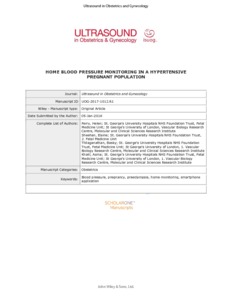Perry, H; Sheehan, E; Thilaganathan, B; Khalil, A
(2018)
Home blood-pressure monitoring in a hypertensive pregnant population.
Ultrasound Obstet Gynecol, 51 (4).
pp. 524-530.
ISSN 1469-0705
https://doi.org/10.1002/uog.19023
SGUL Authors: Thilaganathan, Baskaran Khalil, Asma
![[img]](http://sgultest.da.ulcc.ac.uk/110321/7.hassmallThumbnailVersion/Home%20blood-pressure%20monitoring.pdf)  Preview |
|
PDF
Accepted Version
Available under License ["licenses_description_publisher" not defined].
Download (282kB)
| Preview
|
Abstract
OBJECTIVE: The majority of patients with chronic or gestational hypertension do not develop pre-eclampsia. Home blood-pressure monitoring (HBPM) has the potential to offer a more accurate and acceptable means of monitoring hypertensive patients during pregnancy compared with traditional pathways of frequent outpatient monitoring. The aim of this study was to determine whether HBPM reduces visits to antenatal services and is safe in pregnancy. METHODS: This was a case-control study of 166 hypertensive pregnant women, which took place at St George's Hospital, University of London. Inclusion criteria were: chronic hypertension, gestational hypertension or high risk of developing pre-eclampsia, no significant proteinuria (≤ 1+ proteinuria on dipstick testing) and normal biochemical and hematological markers. Exclusion criteria were maternal age < 16 years, systolic blood pressure > 155 mmHg or diastolic blood pressure > 100 mmHg, significant proteinuria (≥ 2+ proteinuria on dipstick testing or protein/creatinine ratio > 30 mg/mmol), evidence of small-for-gestational age (estimated fetal weight < 10th centile), signs of severe pre-eclampsia, significant mental health concerns or insufficient understanding of the English language. Pregnant women in the HBPM group were taught how to measure and record their blood pressure using a validated machine at home and attended every 1-2 weeks for assessment depending on clinical need. The control group was managed as per the local protocol prior to the implementation of HBPM. The two groups were compared with respect to number of visits to antenatal services and outcome. RESULTS: There were 108 women in the HBPM group and 58 in the control group. There was no difference in maternal age, parity, body mass index, ethnicity or smoking status between the groups, but there were more women with chronic hypertension in the HBPM group compared with the control group (49.1% vs 25.9%, P = 0.004). The HBPM group had significantly fewer outpatient attendances per patient (6.5 vs 8.0, P = 0.003) and this difference persisted when taking into account differences in duration of monitoring (0.8 vs 1.6 attendances per week, P < 0.001). There was no difference in the incidence of adverse maternal, fetal or neonatal outcome between the two groups. CONCLUSION: HBPM in hypertensive pregnancies has the potential to reduce the number of hospital visits required by patients without compromising maternal and pregnancy outcomes. Copyright © 2018 ISUOG. Published by John Wiley & Sons Ltd.
| Item Type: |
Article
|
| Additional Information: |
This is the peer reviewed version of the following article: Perry, H. , Sheehan, E. , Thilaganathan, B. and Khalil, A. (2018), Home blood‐pressure monitoring in a hypertensive pregnant population. Ultrasound Obstet Gynecol, 51: 524-530, which has been published in final form at https://doi.org/10.1002/uog.19023. This article may be used for non-commercial purposes in accordance with Wiley Terms and Conditions for Use of Self-Archived Versions. |
| Keywords: |
blood pressure, home monitoring, pre-eclampsia, pregnancy, smartphone application, Adult, Blood Pressure Monitoring, Ambulatory, Case-Control Studies, Female, Humans, Hypertension, Pregnancy-Induced, Mobile Applications, Pre-Eclampsia, Pregnancy, Pregnancy Outcome, Prenatal Care, Retrospective Studies, Self Care, Humans, Hypertension, Pregnancy-Induced, Pre-Eclampsia, Blood Pressure Monitoring, Ambulatory, Pregnancy Outcome, Prenatal Care, Self Care, Case-Control Studies, Retrospective Studies, Pregnancy, Adult, Female, Mobile Applications, blood pressure, home monitoring, pre-eclampsia, pregnancy, smartphone application, blood pressure, home monitoring, pre-eclampsia, pregnancy, smartphone application, 1114 Paediatrics And Reproductive Medicine, Obstetrics & Reproductive Medicine |
| SGUL Research Institute / Research Centre: |
Academic Structure > Molecular and Clinical Sciences Research Institute (MCS) |
| Journal or Publication Title: |
Ultrasound Obstet Gynecol |
| ISSN: |
1469-0705 |
| Language: |
eng |
| Dates: |
| Date | Event |
|---|
| 10 April 2018 | Published | | 22 February 2018 | Published Online | | 30 January 2018 | Accepted |
|
| Publisher License: |
Publisher's own licence |
| PubMed ID: |
29468771 |
| Web of Science ID: |
WOS:000429585800016 |
 |
Go to PubMed abstract |
| URI: |
http://sgultest.da.ulcc.ac.uk/id/eprint/110321 |
| Publisher's version: |
https://doi.org/10.1002/uog.19023 |
Statistics
Item downloaded times since 28 Nov 2018.
Actions (login required)
 |
Edit Item |



